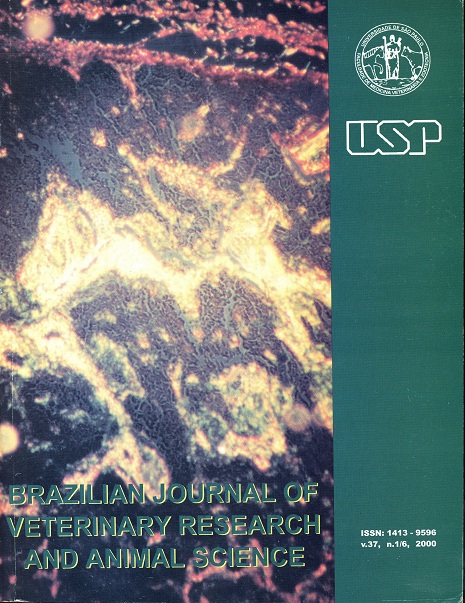Use of probiotic with Lactobacillus acidophilus, Streptococcus faecium and Sacharomyces cerevisae in veal calves diet: effects on performance and meat quality
DOI:
https://doi.org/10.1590/S1413-95962000000500013Keywords:
Calves, Probiotics, Nutrition, GrowthAbstract
Fourteen Holstein-Zebu calves were used to evaluate the effects of probiotic with Lactobacillus acidophilus, Streptococcus faecium and Sacharomyces cerevisae in diet on performance and meat quality of veal calves. Calves were randomly assigned in two treatments: whole milk and whole milk with probiotic. Calves were weight at birth and every fifteen days until slaughter, between 160 and 190 kg body weight. Body weight daily gain, dry matter intake, feed efficiency, dressing percentage of carcass, fecal score and sensorial analyses in Longissimus dorsi muscle were evaluated in a completely randomized block design. Data were interpreted by variance analysis and means compared by F test. Weekly fecal scores were interpreted by non-parametric variance analysis, by Wilcoxon test. Any differences were observed in sensorial analysis of meat samples, and data indicate a quite clear coloration, with compatible intensity of red color wanted by market. Average values of body weight daily gain, feed efficiency, weight and dressing percentage of carcass for both treatments were 892 and 945 g, 1.41 and 1.30, 90.9 and 98.8 kg, 57.1 and 58.3%, respectively, for calves fed whole milk and whole milk with probiotic (p >; 0.05).Downloads
Download data is not yet available.
Downloads
Published
2000-01-01
Issue
Section
ZOOTECHNICS
License
The journal content is authorized under the Creative Commons BY-NC-SA license (summary of the license: https://
How to Cite
1.
Alves PA de PM, Campos OF, Almeida MIV de, Lizieire RS, Modesta RCD, Almeida FQ de, et al. Use of probiotic with Lactobacillus acidophilus, Streptococcus faecium and Sacharomyces cerevisae in veal calves diet: effects on performance and meat quality. Braz. J. Vet. Res. Anim. Sci. [Internet]. 2000 Jan. 1 [cited 2024 Apr. 18];37(5):416-22. Available from: https://revistas.usp.br/bjvras/article/view/5794





